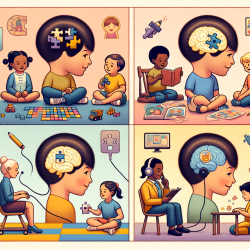Understanding the Genetic Substrates of Autism Spectrum Disorder
Autism Spectrum Disorder (ASD) is a complex neurodevelopmental condition with a wide range of symptoms and severity levels. Recent research has shed light on the genetic underpinnings of ASD, offering new avenues for practitioners to enhance their understanding and treatment strategies. The study titled "Quantitative trait locus analysis for endophenotypes reveals genetic substrates of core symptom domains and neurocognitive function in autism spectrum disorder" provides valuable insights into the genetic factors influencing ASD.
Key Findings from the Research
The study utilized data from the Autism Genetic Resource Exchange, analyzing whole-genome sequencing data from 3,833 individuals. The researchers performed an endophenotype-wide association study to identify genetic variants associated with neurocognitive development and ASD core symptoms. Notably, they discovered significant associations between nine genetic variants and six endophenotype scores, highlighting the role of genetic factors in ASD.
One of the most intriguing findings was the association between multiple variants in the VPS13B gene and the Stereotyped Behaviors and Restricted Interests score from the Autism Diagnostic Observation Schedule (ADOS) Module 3. This gene is a known causal factor for Cohen syndrome and a candidate gene for syndromic ASD. These discoveries emphasize the importance of genetic research in understanding the phenotypic heterogeneity of ASD.
Implications for Practitioners
For practitioners working with children with ASD, these findings offer several practical implications:
- Enhanced Assessment: Incorporating genetic insights into assessment protocols can provide a more comprehensive understanding of a child's unique ASD profile. This can lead to more tailored intervention strategies.
- Targeted Interventions: Understanding the genetic basis of specific ASD symptoms can guide the development of targeted interventions. For example, interventions focusing on stereotyped behaviors might be more effective if they consider the genetic factors involved.
- Collaboration with Geneticists: Collaborating with geneticists can help practitioners stay informed about the latest genetic research and its implications for clinical practice.
Encouraging Further Research
While this study provides valuable insights, it also highlights the need for further research. The identified genetic associations require validation in larger cohorts to confirm their significance. Practitioners are encouraged to stay engaged with ongoing research and consider participating in studies that explore the genetic underpinnings of ASD.
Conclusion
The study on genetic substrates of ASD offers a promising direction for improving outcomes for children with ASD. By integrating genetic insights into clinical practice, practitioners can enhance their assessment and intervention strategies, ultimately leading to better outcomes for children with ASD.
To read the original research paper, please follow this link: Quantitative trait locus analysis for endophenotypes reveals genetic substrates of core symptom domains and neurocognitive function in autism spectrum disorder.










